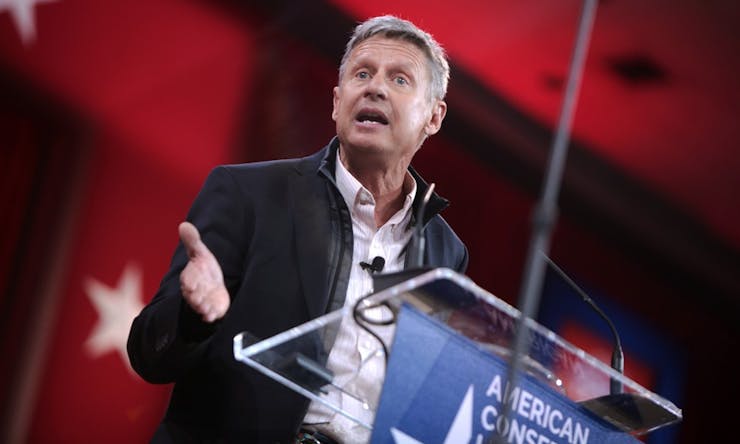Looking for an alternative to the two major party candidates this week? Consider Libertarian presidential candidate Gary Johnson, who’s not only a proud cannabis consumer — he used the be in the business himself. Johnson, the 63-year-old former New Mexico governor, got the full New Yorker profile treatment this week in a feature by political writer Ryan Lizza. Here’s what we learned:
1. It’s been a while for ol’ Gary.
According to Johnson, he has not consumed cannabis since his run for president began picking up steam. “The last time I indulged is about two months ago, with some edibles,” Johnson told the New Yorker.
2. He used to consume about two or three times a week.
Johnson has been quite open about his cannabis consumption. During his first campaign for governor, in 1994, he was asked to quantify his earlier use. “I came up with two and a half times a week,” he told Lizza. He earned plenty of praise from conservatives, as he was a “New Mexico maverick” who cut income-tax rates, slowed the growth of government, and eliminated the jobs of hundreds of state employees.
3. He still believes in his “hi” cannabis company.
When he decided to enter this year’s Presidential race, he stepped down as C.E.O. of Cannabis Sativa Inc., a marijuana-branding company that hopes to benefit as legalization spreads. “Gary is not at all involved with Cannabis Sativa, Inc., now,” James P. Gray, the company’s chairman, said, adding that Johnson still owns some stock. “But he does mention it occasionally in his interviews, and he believes in it.”
4. In fact, Johnson helped develop a strain-specific lozenge for the company.
At the company, Johnson told Lizza, he hired the person who developed the branding for a product line called hi. “Small ‘h,’ small ‘i’ — really cool logo,” he said. He also contributed to the development of a strain-specific edible lozenge, which he said “is as good a marijuana high that exists on the planet.” How did he know? “As C.E.O., I did some testing,” he said. “Nothing was better.”
5. Gary can still hook you up, on the down low.
“So, if someone wanted to try that strain, how would they acquire it?” Lissa asked Johnson.
“Legally, they couldn’t,” Johnson said.
“What about illegally?”
“Well, I’d probably be able to connect you up illegally.”
6. He pledges to be a substance-free commander in chief.
“As president, I will not indulge in anything,” Johnson said. We’re not sure that statement gives us any reassurance about his state of mind. We like our presidents alert but not overstressed.
7. When the red phone rings, it’s better to be high than drunk. If forced to choose.
“I don’t think you want somebody answering the phone at two o’clock in the morning — that red phone — drunk, either. Better on the stoned side, but I don’t want to make that judgement.”
8. He expects to do better than 1 percent this time.
Johnson, New Mexico’s Republican governor from 1995 to 2003, also for president in 2012. He received just under 1 percent of the vote, though he thinks this year could be different. The Libertarian party now boasts one of the most mainstream tickets in the party’s history, with William Weld, the former moderate Republican governor of Massachusetts, as the party’s vice-presidential nominee. When pollsters include Johnson with Trump and Clinton in their surveys, Johnson has been pulling around 10 percent of the respondents. In a Times/CBS News poll released this past week, he hit 12 percent. You’ll hear Johnson bring this up a lot in interviews, but his main goal right now is to get up to 15 percent in the national polls. If he does that, he will likely be invited to participate in the national debates with both Trump and Clinton.
9. Debate appearances are the lynchpin of his campaign.
“If you’re not in the debates, there’s no way to win,” Johnson said. “It’s the Super Bowl of politics.”
10. Gaining a vote is like legalizing cannabis. It’s a step-by-step process that starts with a conversation.
“It’s similar to the legalization of marijuana,” Johnson told the New Yorker. “For those who wanted to implement the death penalty for marijuana, they don’t go from death penalty to legalizing. They go from death penalty to ‘O.K., let’s forget about the death penalty.’ So you move the needle. And right now we’re moving the needle.”
Photo by Gage Skidmore










